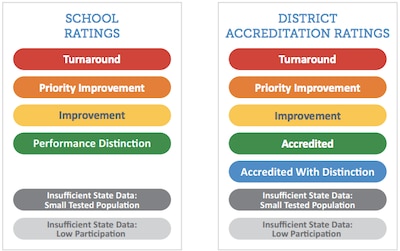A new report on Colorado schools operating under state-approved improvement plans shows mixed academic results and slow progress getting all the necessary pieces in place.
State education department officials on Wednesday briefed the State Board of Education on schools and districts halfway through their first year on the plans.
State staff praised Aurora Central High School, noting that leadership in Aurora’s innovation zone and the consultant hired to help are providing good feedback to teachers as they focus in on improvements to the school. The data also show Aurora Central is making “small increases” in academic progress and more significant progress in attendance numbers.
The report also highlights problems that have come up in other schools or districts working on their plans. One example: Administrators in the Aguilar school district realized their language arts curriculum was not aligned to state standards. The report, however, noted that the district “moved immediately to work to adopt new materials,” mid-year with help from its consultant.

Adams 14 and its high school, Adams City High School, along with three schools from Pueblo City Schools, will be required to return to the state board for an evaluation if they do not earn an “improvement” rating or higher this year. The preliminary ratings will be available in August and finalized later in the fall.
Other schools and districts that were put on state-approved improvement plans last year, including the Westminster district and Aurora Central High School, have until 2019 to show improvements.
State officials are monitoring the progress of the schools and districts through site visits, data reviews, and grants. The state board next will be updated when the preliminary ratings are available.
Officials report that schools and districts are seeing a slower rollout of their plans than expected. In many cases, officials say, schools or districts have not built out the infrastructure and routines required to make their plans work. In other cases, other community issues are distracting educators from the work of the improvement plans.
“There’s some common themes,” Alyssa Pearson, an associate education commissioner, said during the presentation to the board. “But how it plays out… it’s different everywhere.”
Both are true in Adams 14. Community members have criticized the district for changes to recess, parent-teacher conferences, and more. The district has also been slow to learn to use its new school monitoring systems, the report said.
“While progress monitoring data is being collected, it is not routinely analyzed and discussed by school staff,” the state’s report notes. “For example, elementary data meetings are scheduled after school and staff attend on an optional basis.”
The mid-year report also notes that the Adams 14 data does not show the district meeting targets in math or literacy, although the middle schools were noted to be showing the “most consistent growth.”
At Adams City High School, a “lack of a valid interim assessment makes it difficult for the school, district and state to determine overall academic progress in the school” is a problem, the report concludes. According to the report, the district and school “have agreed” to use a valid interim assessment next year.
Read the mid-year progress summaries here:
Correction: This article has been updated to reflect that officials in the Aguilar school district discovered the problem with their language arts curriculum on their own, rather than state officials notifying them.

